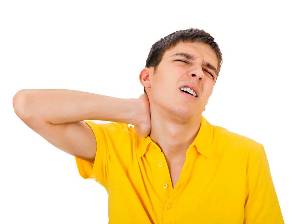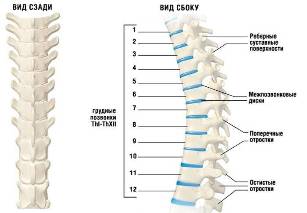Currently, according to the medical statistics, the symptoms of cervical degenerative disc disease, nearly all people older than 25-30 years are complaining. The disease affects this division of the spine more frequently than others. The pathology is a Progressive degenerative process that affects the intervertebral discs and vertebrae in the neck. The disease is widespread and men and women alike. It is a dangerous and complex Form of osteochondrosis, such as in the neck, major blood vessels are in the brain, and a large number of nerve endings. Disorders of Innervation and blood circulation lead to a deterioration in the supply of brain with oxygen and nutrients.

Signs of the disease
The symptoms of degenerative disc of the cervical spine manifest disease more pronounced than in other parts of the spine, even at low damage. This is due to the fact that the vertebrae in the neck are close to each other, and the discs have a small height. This anatomical feature contributes to the fact that osteochondrosis is more commonly compressed nerves, spinal vessels, blood.
General Symptoms:
- Pain syndrome;
- Weakness and decrease in the sensitivity in the upper extremities;
- limited mobility of the neck;
- lack of coordination of movements;
- frequent dizziness;
- General Weakness;
- a deterioration of the function of the organs of perception (hear, see, touch, and taste).
Pain is often localized in the neck, in the nape of the neck, shoulders, hands. The upper extremities hurt when the damaged vertebra, the nerve root provider caught responsible for their Innervation. Pain in the neck due to spastic contractions of the muscles of the neck, use the back of the head of the bone, and a violation of blood circulation in this area.
The weakness of the hands in patients observed when a pathological process of the nerve root, the muscle-Innervation of the structures of the upper extremity involved. Restricted mobility and a characteristic crunch when turning or tilting of the neck caused when the neck, spine, bony growths, the height of the intervertebral discs is reduced appear to homeopathy on the joints between the vertebrae.
The vertebrae in the neck have transverse extensions form a channel in which the artery is feeding the brain. In the case of the osteochondrosis of the cervical vertebrae of the spine move, on them, the connective tissue grows. This leads to a feeling of pressure neck artery, a deterioration of the blood supply of the cerebellum and the posterior regions of the brain. In the result, the people had frequent dizziness, disturbed coordination of movements, General weakness. In advanced cases, when the artery involved in the pathological process or severely pinched, the small brain supplied with blood, the back of the head and brain stem significantly deteriorated. In this case, the functionality of the organs of hearing and vision, decrease numbness of the tongue, of the fingers observed.
Symptoms of the disease are dependent on and which of the eight vertebral amazed dystrophic or inflammatory process. Lead to disturbances of sensibility and of motion damage to spinal roots that influence the one or the other vortex. Depending on the following symptoms of cervical degenerative joined disease disc:

- the first vertebra of the neck deaf Institute and the occipital part of the head, reduces sensitivity;
- the second feels pain in the area of the head and neck;
- the third feels the pain and reduces the sensitivity in the part of the neck, where the spinal nerve root, is wedged in the intensity of the taste, reduces disorders of language are present;
- the fourth – pain radiating in the shoulder, the scapula, the patient's cardiac pain, diseases of the respiratory tract, disrupt decreases the Tonus of the muscles of the neck;
- the cold – pain in the neck is marked in red, in the outer surface of the shoulder;
- sixth – neck pain radiating to the shoulder blade, felt in the forearm and thumb;
- seventh – pain radiating in the shoulder, the rear part of the shoulder, forearm and the fingers of the hands (from the second to the fourth);
- eighth – pain extending from the neck to the shoulders, the forearms and Pinkies.
Depending on the extent of the lesions four grades distinguished from degenerative disc of the neck, diseases of the spine. It is not the stage of the disease and the severity of the symptoms, due to the fact of just how widespread pathological process, which affects the vertebrae.
- In the first stage, the clinical symptoms are absent or minimal occur. The patients complain of mild pain, worse when moving the head. Effective the treatment will be started in this Phase of the disease. However, people often ignore the warning signs and you feel that's not why the doctor does not treated.
- Exacerbation of the pathological process increases the symptoms. In the second Phase, the pain is more pronounced in the upper limb, shoulder blade. In this Phase of the development of the degenerative process, the height of the intervertebral disc is reduced, whereby there is a herniation of the nerve fiber. It is and will be a reason of the increasing pain. For the second degree of osteochondrosis of the cervical spine of the work is by the appearance of headache, deterioration of health, reduction in ability.
- The third degree of the cervical degenerative disc disease is the formation of hernias of the affected intervertebral disc. The mobility of the neck is restricted, and Palpation of the Patient feels severe pain. With such a spread of the pathological process be permanently pain, radiating into the upper limbs. You can feel the tension of the muscles attached to the occipital bone use. Patients complain of frequent dizziness, General weakness, numbness in the hands.
- The fourth degree of cervical degenerative disc disease is diagnosed when the intervertebral disc is completely destroyed dystrophic process. He is replaced by connective tissue, leading to a significant restriction of mobility. Amazed at the spinal cord and marked blood vessels in the neck. Such changes are due to a significant deterioration of the blood supply of the cerebellum and the occipital part of the brain. Oxygen deficiency leads to a disturbance of coordination of movements, impairment of hearing, vision, speech, numbness, disorders of language.
Treatment methods
Timely treatment to the doctor at the first disturbing symptoms, discomfort in the neck, the reaction of the nervous system will not prevent the progression of degenerative changes. The treatment of cervical osteochondrosis consists of a complex of therapeutic measures. Among Them:
- Taking medications;
- Massage;
- Remedial gymnastics;
- physiotherapy treatments.
Drug Therapy
Doctors anti prescribe anti-inflammatory medications to reduce the intensity of pain, reducing inflammation and swelling of the nerve root. Chondroprotectors regenerate damaged tissues of cartilage in the intervertebral disc. Muscle relaxants relax the neck muscles, spasm relieve. Medicines to improve blood circulation, help to renew the disturbed blood supply to the brain. B-vitamins stimulate the tissues of the metabolism in the nerves. In the case of intense pain the doctor may prescribe analgesics can. If the Patient has severe pain, the painkillers introduced parenterally, once the pain of the transition to tablets will subside.
Physiotherapeutic Methods
Physical therapy – the effective way of struggle with osteochondrosis of the cervical spine. To treat the disease, not necessarily with the use of such techniques, the results of which revealed the following results:
- reduces the intensity of the pain;
- enabled to use the restoration of diseased bone, cartilage and muscle tissue;
- spasm and tension decreased in the muscles;
- inflammatory process docked;
- improves the delivery of oxygen and nutrients in the affected area and the brain.
The most effective in the treatment of degenerative disc disease apply to the following types of procedures:
- Iontophoresis (on the affected area to act as an electric shock, which enhances the activation of blood flow and tissue repair, the delivery of the active ingredient of the drug to the affected tissues are caused by degenerative processes);
- Ultrasound therapy (activates the metabolism in the diseased area, reduces pain, docked inflammation);
- Magnetic field therapy (relieves swelling in the affected area, which helps to reduce the intensity of the pain);
- Laser therapy (improves blood circulation in the area of the pathological process, has an anti-inflammatory effect).
Physiotherapy
The exercises are in the period when the docked acute symptoms of the disease. During the gymnastics to not feel may be discomfort and pain. To perform the complex should be to achieve Remission, to prevent relapse.

- You take the Position, to lift lying on the belly, the head and the housing, supported on the hands. The back is straight, the breathing deep and smooth. Stay in one Position for a Minute or two, then slowly to the beginning position. The number of repetitions – 3.
- Position – lying on the belly, hands along the body. Slowly you turn your head, trying to touch the ear to the ground. Repeat 6 times on each side.
- Sitting or standing, on the inhalation, tilt the head, trying to reach, from the chin to the chest. On the exhale, gently take them back to the head, his eyes to the ceiling. The number of repetitions of 10-15.
- A good exercise to strengthen the muscles of the neck – pressure on the forehead, squeezing his Hand. To achieve the effect you need to land on the forehead and hand, forehead, and palms of the hands within 30 seconds. You repeat three times.
- Rotate the head in a circle. The exercise should be slow, gentle. In each direction after 10 turns. Prohibited dizziness occurs during the execution of the movements. If this happens, you should stop immediately.
Massage
The course appointed doctor, and in the absence of acute pain, only a Person with medical training can lead to. In this disease, not the Amateurs contact.
The healing effect of the Massage the neck area:
- improves the flow of blood and lymph in the affected area;
- the muscles, relaxes spasm, removes;
- the intensity of pain is reduced.
Surgical Procedures
The process shows, if the conservative therapy works within a period of six months, the patients tormented by severe pain, signs of damage to the nerve fibers and myelopathy. If osteochondrosis of the neck, extends vertebral column with complications, there is the risk for a stroke, there is a strong contusion of the spinal cord, then surgery is necessary.
According to the statements, resorted to the following types of surgery:
- endoscopic discectomy – removal of part or an entire intervertebral disc;
- the laminotomie – excision of bands and provisions bone use particles bone density (often combined with laminoplasty – construction of artificial plates for the enlargement of the spinal canal);
- Laser vaporization disc-Kernel – splitting of the nucleus of the intervertebral disc through the laser beam simultaneously with the destruction of the destroyed fragments;
- with cold plasma nucleoplastie – instead of the endoscope used, long and thin, hollow needle is inserted into the intervertebral disc, by you to the site of the defeat of the electrode, the cold plasma effects deliver.
Neck – a complex Organ in which the major blood vessels, spinal cord. They are easy to damage, so surgery use not more than 5% of the cases. Surgical treatment is often accompanied by the development of complications. Among Them:
- inflammatory process in tissues or sleeves of the spinal cord;
- Osteomyelitis;
- Scarring leads to narrowing of the arterial, and cerebrospinal channels.
Operations on the cervical spine complicated and require a long rehabilitation period. The patient's recovery after surgery takes six months and more.
Prevention
To prevent the development of cervical degenerative disc diseases:
- the Position of the spine and neck to monitor;
- lead an active lifestyle, move more and more;
- doing exercise, you need to be careful, note the correctness of the implementation, since even small injuries can impact on the Status of the musculoskeletal system;
- make sure the correct Position of the body during sleep, buy, or orthopedic anatomic mattress;
- right the workplace to equip, where a person spends a lot of time;
- exercise regularly physical culture;
- to follow the diet, ensure the recovery of all useful mineral substances, the use for strong bone, especially Magnesium and calcium;
- constantly dispensary to pass disease tests for the early detection of degenerative intervertebral disc.
Prevent helps prevent degenerative changes in the cervical spine, protects against pain, dizziness, numbness of the limbs, and other unpleasant symptoms.






























